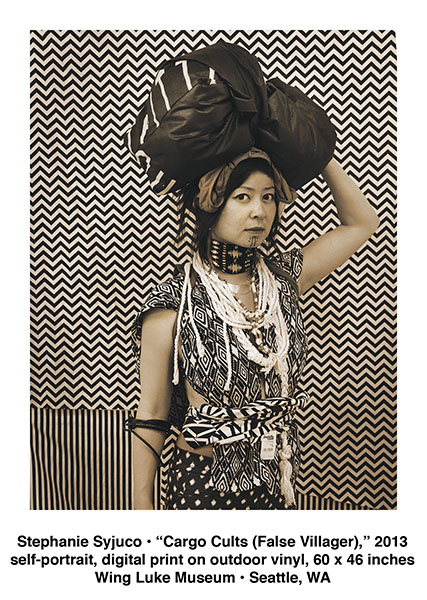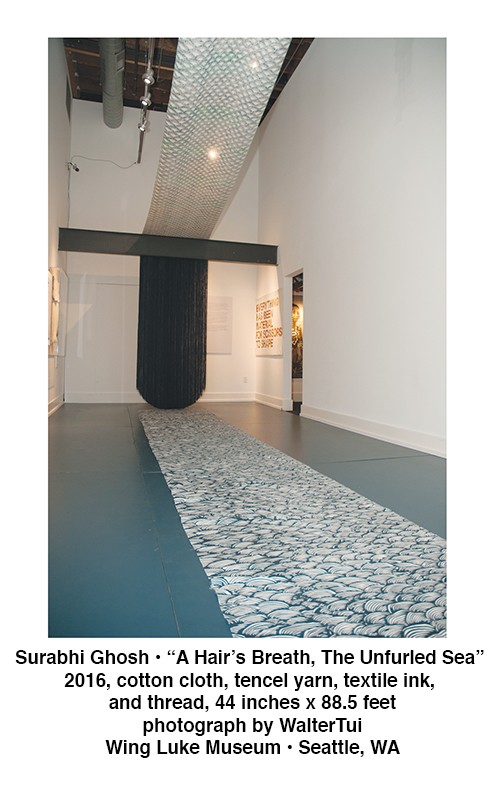 The title of this stunning exhibition at the Wing quotes from Pablo Neruda’s “Odes to Common Things” which celebrates scissors in every imaginable way including cutting clothes for people from the cradle to the grave. In “Everything has been Material for Scissors to Shape” Stephanie Syjuco, Surabhi Ghosh, and Aram Han Sifuentes, create dramatic textile-based installations that comment on history, mythology and the exploitations of commodity culture. Adding resonance to their work, Portland-based Guest Curator Namita Gupta Wiggers incorporated historical selections from the Museum’s permanent collection into the exhibition.
The title of this stunning exhibition at the Wing quotes from Pablo Neruda’s “Odes to Common Things” which celebrates scissors in every imaginable way including cutting clothes for people from the cradle to the grave. In “Everything has been Material for Scissors to Shape” Stephanie Syjuco, Surabhi Ghosh, and Aram Han Sifuentes, create dramatic textile-based installations that comment on history, mythology and the exploitations of commodity culture. Adding resonance to their work, Portland-based Guest Curator Namita Gupta Wiggers incorporated historical selections from the Museum’s permanent collection into the exhibition.
As we enter the first gallery, “A Hair’s Breath, the Unfurled Sea” by Surabhi Ghosh, forms a canopy the length of the gallery, then drops down and flows over the floor. The artist painted the homespun khadi fabric with a pattern that suggests the waves of the sea on the ground and the scales of a flying serpent above. At one end the fabric ends in a curtain of long blue threads that resemble hair. On the wall is an unpainted Khadi bag, its raw cotton physicality reminding us that Khadi connects to Gandhi who spun it, wove it and wore it and encouraged all Indians to do the same, as a means of resistance to colonial rule. Great Britain took India’s cotton at bargain rates, then sold it back as fabric at exorbitant prices. Today, khadi has near sacred status, it cannot be sold or exported, but Ghosh managed to bring the fabric back in her suitcase. 
While the celestial snake Ananta supports the universe above our heads, the rest of the sweeping fabric refers to a dramatic story about Draupadi, the central female figure of the Hindu epic Mahabharatha. Draupadi asks Krishna to save her honor after she is sold in a card game and forced to disrobe and dishonor herself: her sari becomes endless, the long blue threads suggest her hair that is also protecting her. Celestial serpents, magic saris, and anti colonialism, all connect in this installation.
Stephanie Syjuco’s self portraits “Cargo Cults (False Villager)” seem to present a young woman dressed in traditional “native” garb, while actually the artist has purchased all of her clothes and adornments from import stores like Pier I. Syjuco creates the “look” of a “native,” from the fake traditional fabrics and objects, then returns all of them to the store. Around her neck in one photograph, she wears door numbers inverted, that look like a tradition-laden symbolic necklace. The term “cargo cult” refers to post World War II Pacific Islanders who gained status by acquiring commodity items dropped on them from the sky to support troops stationed there.
Facing the photographs and further playing with the theme of authentic/inauthentic, baskets from the Wing collection range from ancient and valuable containers to unidentified woven baskets that might actually be cheap imports. The creative display underscores the charisma of museum techniques that can endow objects with authenticity just by means of arrangement and lighting.
 In the third gallery, Aram Han Sifuentes created “A Mend, A Collection of Scraps From Local Seamstresses and Tailors,” 2011-2013 with the cut off legs of blue jeans. Its sagging gapping forms suggests a weak wall with holes in it, an incomplete quilt, an incomplete story. The artist collected the story of each workers who cut jeans. She listed the people that she interviewed in a small chart which outlines how many years they have been in the US, how many worked as a seamstress, their country of origin, and what work (in many cases a profession), they had in their country of origin. Also paired in this display are archival interviews with garment workers recorded by Wing Luke Museum in 2001, from textile workers in the Pacific Northwest, women who created the clothing that has made us famous.
In the third gallery, Aram Han Sifuentes created “A Mend, A Collection of Scraps From Local Seamstresses and Tailors,” 2011-2013 with the cut off legs of blue jeans. Its sagging gapping forms suggests a weak wall with holes in it, an incomplete quilt, an incomplete story. The artist collected the story of each workers who cut jeans. She listed the people that she interviewed in a small chart which outlines how many years they have been in the US, how many worked as a seamstress, their country of origin, and what work (in many cases a profession), they had in their country of origin. Also paired in this display are archival interviews with garment workers recorded by Wing Luke Museum in 2001, from textile workers in the Pacific Northwest, women who created the clothing that has made us famous.
Finally, an interactive exhibit offers viewers an opportunity to create their own embroidery based on historical stitches.
The combination of hands on activity, stunning contemporary art, and connections to Asian Pacific American history is vintage Wing Museum. The museum pioneers community-based exhibitions, chosen and curated by community members, such as the second show on display, “Naga Sheds Its Skin” about Khmer Americans, their history, their language, their contemporary presence in the United States, and the horrifying statistics on their deportations.
Also on exhibit is Part III of the Bruce Lee exhibitions, “A Day in the Life of Bruce Lee,” which opened on October 1. Martial artist Bruce Lee defied racism in Hollywood and in his life. His gravesite here is an ongoing shrine and performance focus for people from all over the world. (There is a new biopic about him raising new accusations of racism from his daughter).
Opposite the Tsutakawa Gallery, the permanent display “Honoring our Journey,” presents painful histories (best known of which is the Japanese incarceration during World War II), and contemporary culture in the US of some of the fifty- one (!) ethnic groups included in the Museum.
Finally there is the historical tour of the other side of the 1910 museum building, the East Kong Yick building, the preserved living quarters and cultural center for hundreds of immigrants.
This remarkable museum in the International District is one of my favorite destinations in Seattle, both for its remarkable contemporary art exhibitions as well as its pioneering museology techniques that engage people of all ages and backgrounds.
Susan Noyes Platt, Ph.D.
Susan Noyes Platt, Ph.D. is an art historian, art critic, curator, and activist. She continues to address politically engaged art on her blog www.artandpoliticsnow.com.
“Everything has been Material for Scissors to Shape” is on view through April 17, Tuesday through Sunday from 10 A.M. through 5 P.M. at The Wing Luke Museum of the Asian Pacific American Experience, located at 719 South King Street in Seattle, Washington. For more information, visit www.wingluke.org.